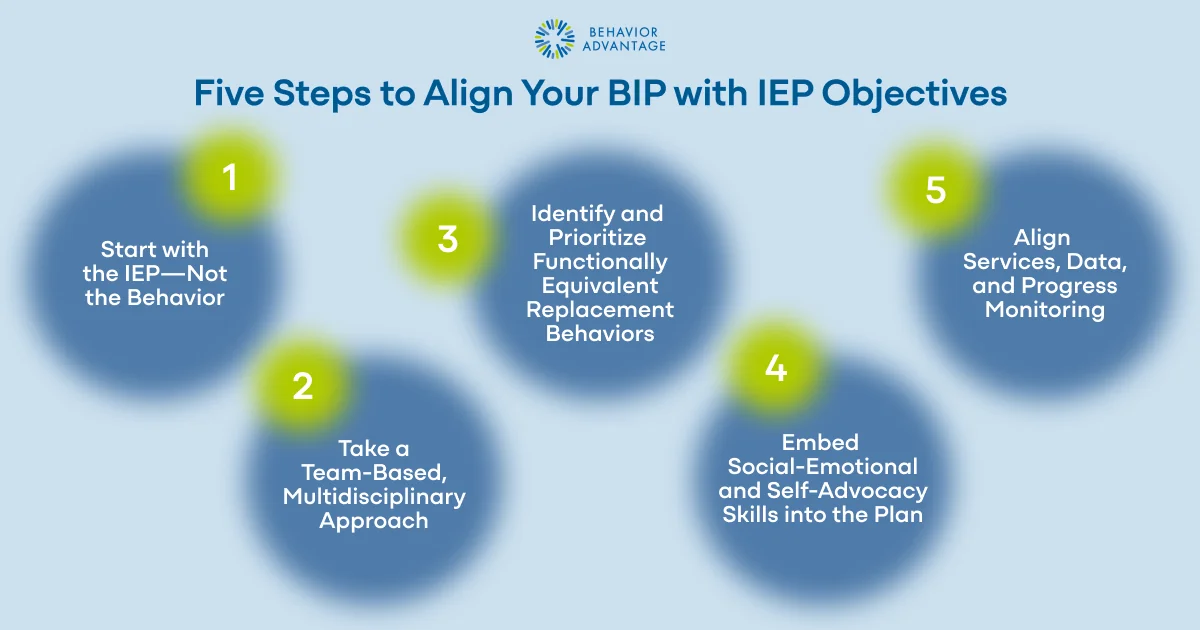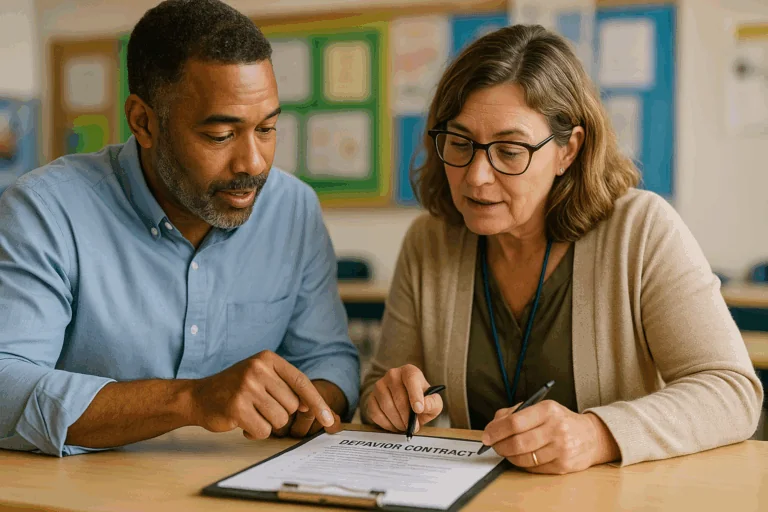When a student’s behavior begins to interfere with learning—either their own or that of others—a Behavior Intervention Plan (BIP) becomes an essential tool for support. But too often, BIPs are developed in isolation from the rest of the student’s Individualized Education Program (IEP), resulting in scattered efforts, duplicated strategies, or unclear goals.
To be effective, a BIP should not stand alone. Instead, it must be an integrated, team-driven part of the IEP process that supports academic, social-emotional, and behavioral growth in a cohesive way. That integration starts with alignment—making sure your BIP is directly connected to the student’s IEP goals and objectives.
And at the heart of that alignment? Clear, teachable, functionally appropriate replacement behaviors.
Here’s why that matters—and how your team can get it right, in five steps.
Step 1: Start with the IEP—Not the Behavior
A strong BIP doesn’t just react to behavior. It builds on the IEP’s existing understanding of the student’s strengths, needs, and services.
Start by reviewing the current IEP with a multidisciplinary lens:
- What are the student’s present levels of performance?
- What academic, communication, or self-regulation goals already exist?
- Are there accommodations or supports that relate to the behavioral concern?
For example, a speech-language goal targeting expressive language may support a replacement behavior for verbal refusal. A social-emotional goal teaching emotion identification or coping strategies might align with a BIP focused on reducing aggression or elopement.
By grounding the BIP in the IEP, you avoid starting from scratch. Instead, you ensure the plan is informed by team expertise and supports already in place—maximizing efficiency, consistency, and the student’s opportunity for success.
You can learn more about this in our recent blogs: The Role of BIPs in Special Education and Understanding SEL Goals for IEPs: What Are They and How to Use Them.
Step 2: Take a Team-Based, Multidisciplinary Approach
Challenging behavior is rarely just a “behavior issue.” It’s usually tied to communication needs, emotional regulation, executive functioning, academic challenges, or environmental stressors. That’s why the most effective behavior planning is a team effort.
- Teachers bring insight into classroom routines, expectations, and daily patterns.
- School psychologists and counselors provide social-emotional, trauma-informed, and mental health expertise.
- Speech-language pathologists help identify how communication challenges may underlie behavior.
- Behavior specialists or BCBAs guide the functional behavior assessment (FBA) and evidence-based intervention strategies.
- Families contribute valuable input about what works at home and the student’s history, interests, and culture.
Together, the team identifies patterns, evaluates needs, and designs behavior supports that are functionally relevant, developmentally appropriate, and aligned with IEP goals. This collaboration ensures that the student’s replacement behaviors are not only well-matched to the function of behavior, but also teachable, measurable, and reinforced across settings.
New to BIPs? Start with What Is a BIP (Behavior Intervention Plan) with Examples
Step 3: Identify and Prioritize Functionally Equivalent Replacement Behaviors
The primary goal of a BIP is not just to reduce challenging behavior—it’s to teach functionally appropriate replacement behaviors that help students meet their needs in socially acceptable ways.
A replacement behavior should:
- Serve the same function as the challenging behavior
- Be easier or more effective than the behavior it replaces
- Be observable, measurable, and teachable
- Be appropriate for the student’s developmental and social context
Examples:
- If a student escapes difficult tasks by throwing materials, a replacement behavior might be asking for help or requesting a break.
- If a student seeks attention by interrupting, a replacement behavior might be raising a hand or using a visual signal.
These replacement behaviors should be explicitly taught, practiced, and reinforced throughout the school day. Most importantly, they should be reflected in the IEP through clearly written behavior goals.
Need help writing those goals? Find out more in our detailed guide: How to Write Effective Behavior IEP Goals (it includes a Free IEP Goals Examples Template)
Step 4: Embed Social-Emotional and Self-Advocacy Skills into the Plan
Challenging behaviors often reflect missing social-emotional or self-advocacy skills—and these are frequently the most relevant replacement behaviors to teach.
For example:
- Instead of yelling, a student learns to request a break.
- Instead of shutting down, they learn to ask for help or use a coping strategy.
- Instead of seeking attention disruptively, they learn to greet or initiate appropriately.
When aligned with the function of the behavior, these skills give students a more appropriate and effective way to get their needs met. They should be directly taught, practiced, and reinforced—and reflected in both the BIP and the IEP through goals like:
- Identifying emotions
- Requesting support
- Using self-regulation strategies
- Describing personal learning needs
Teaching these skills isn’t extra—it’s the intervention.
Want to explore further? Check out our piece on What Are Self-Advocacy IEP Goals to see how these objectives can be embedded in the BIP.
Step 5: Align Services, Data, and Progress Monitoring
Once your BIP is aligned with the IEP, the next step is ensuring services and data systems are also aligned. That includes:
- Direct services such as behavioral coaching, counseling, or social skills instruction targeting replacement behaviors
- Consistent data collection tools (e.g., daily point sheets, behavior frequency trackers, or self-monitoring logs)
- Clear progress monitoring that connects the student’s replacement behavior performance to their IEP goals
- Team meetings to regularly review data, evaluate effectiveness, and adjust strategies as needed
The more closely your team connects services and supports to skill development goals, the more likely the student will build sustainable habits that support long-term success.

Need a template? How to Write a Behavior Intervention Plan That Works walks you through the process of writing a Behavior Intervention Plan with specific examples.
Final Thoughts: BIPs Should Build Skills, Not Just Reduce Behavior
It’s easy to fall into the trap of writing a BIP to manage or suppress a student’s behavior. But behavior plans aren’t just about removing barriers—they’re about building new, functional, and empowering skills.
Replacement behaviors—especially those rooted in communication, self-regulation, and self-advocacy—are often the missing skills students need to succeed. When your BIP is aligned with the student’s IEP goals and is supported by a collaborative, multidisciplinary team, it becomes a powerful roadmap for student growth.
Behavior planning doesn’t need to be complicated. But it does need to be intentional, instructional, and integrated.
Want a Simpler Way to Align BIPs with IEP Goals?
Behavior Advantage makes it easier for educators to create function-based behavior plans, set measurable goals, and collaborate across teams. Our platform streamlines everything from behavior tracking to IEP alignment—so you can spend more time supporting students.
Let’s see how we can help your team align BIPs with IEP objectives, identify meaningful replacement behaviors, and improve outcomes for students.









